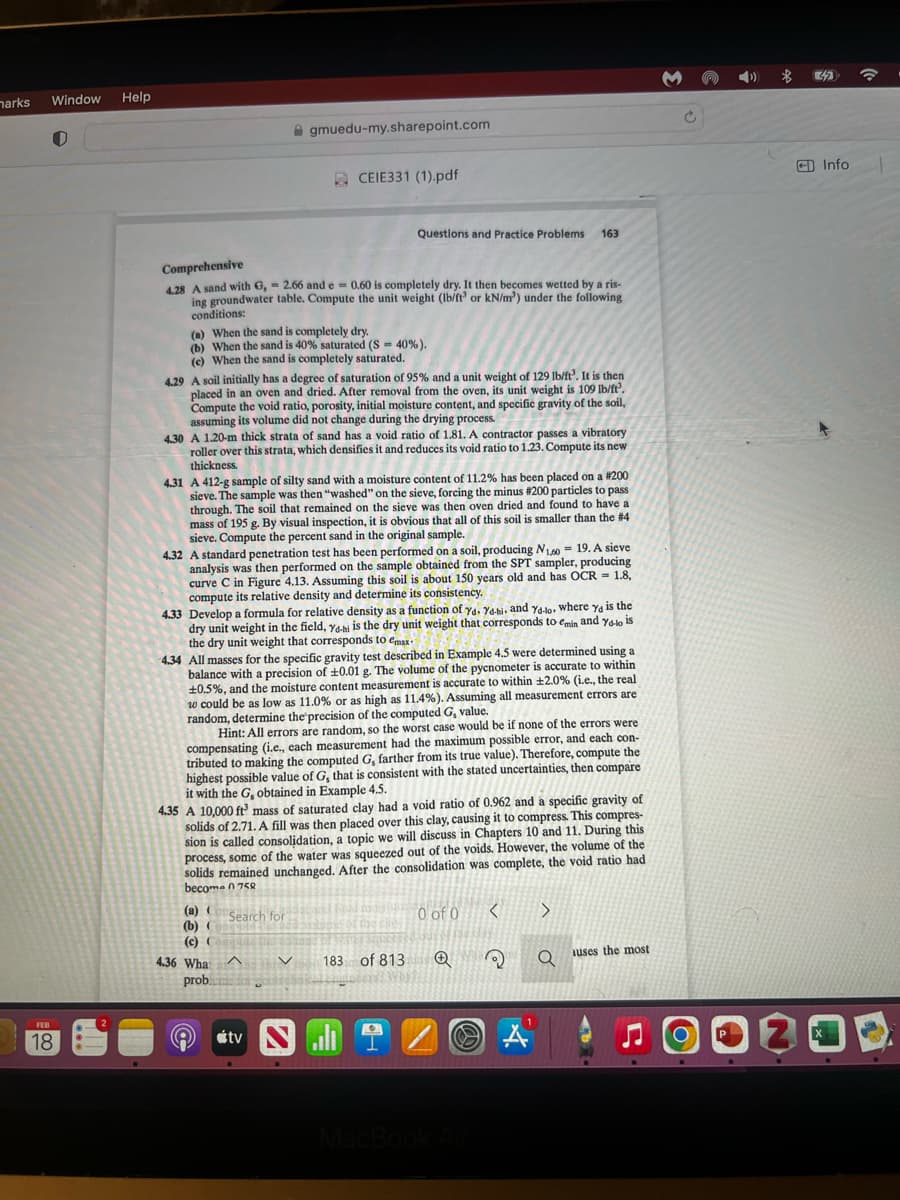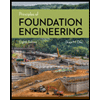4.29 A soil initially has a degree of saturation of 95% and a unit weight of 129 lb/ft'. It is then placed in an oven and dried. After removal from the oven, its unit weight is 109 lb/ft. Compute the void ratio, porosity, initial moisture content, and specific gravity of the soil, assuming its volume did not change during the drying process.
4.29 A soil initially has a degree of saturation of 95% and a unit weight of 129 lb/ft'. It is then placed in an oven and dried. After removal from the oven, its unit weight is 109 lb/ft. Compute the void ratio, porosity, initial moisture content, and specific gravity of the soil, assuming its volume did not change during the drying process.
Principles of Foundation Engineering (MindTap Course List)
9th Edition
ISBN:9781337705028
Author:Braja M. Das, Nagaratnam Sivakugan
Publisher:Braja M. Das, Nagaratnam Sivakugan
Chapter5: Soil Improvement And Ground Modification
Section: Chapter Questions
Problem 5.13P
Related questions
Question
Please solve question 4.29 and explain the steps please. Thank you

Transcribed Image Text:marks Window
FEB
18
Help
Comprehensive
4.28 A sand with G, = 2.66 and e=0.60 is completely dry. It then becomes wetted by a ris-
ing groundwater table. Compute the unit weight (lb/ft or kN/m') under the following
conditions:
gmuedu-my.sharepoint.com
(a) When the sand is completely dry.
(b) When the sand is 40% saturated (S = 40%).
(c) When the sand is completely saturated.
CEIE331 (1).pdf
4.29 A soil initially has a degree of saturation of 95% and a unit weight of 129 lb/ft³. It is then
placed in an oven and dried. After removal from the oven, its unit weight is 109 lb/ft³.
Compute the void ratio, porosity, initial moisture content, and specific gravity of the soil,
assuming its volume did not change during the drying process.
4.30 A 1.20-m thick strata of sand has a void ratio of 1.81. A contractor passes a vibratory
roller over this strata, which densifies it and reduces its void ratio to 1.23. Compute its new
thickness.
4.31 A 412-g sample of silty sand with a moisture content of 11.2% has been placed on a # 200
sieve. The sample was then "washed" on the sieve, forcing the minus # 200 particles to pass
through. The soil that remained on the sieve was then oven dried and found to have a
mass of 195 g. By visual inspection, it is obvious that all of this soil is smaller than the #4
sieve. Compute the percent sand in the original sample.
Questions and Practice Problems 163
4.32 A standard penetration test has been performed on a soil, producing N160 19. A sieve
analysis was then performed on the sample obtained from the SPT sampler, producing
curve C in Figure 4.13. Assuming this soil is about 150 years old and has OCR 1.8,
compute its relative density and determine its consistency.
4.33 Develop a formula for relative density as a function of Ya, Ya-hi. and Ya-lo, where ya is the
dry unit weight in the field. Yd-hi is the dry unit weight that corresponds to emin and Yo-lo is
the dry unit weight that corresponds to emax.
(a) (
(b) (
(c) Compile
4.34 All masses for the specific gravity test described in Example 4.5 were determined using a
balance with a precision of ±0.01 g. The volume of the pycnometer is accurate to within
+0.5%, and the moisture content measurement is accurate to within ±2.0% (i.e., the real
w could be as low as 11.0% or as high as 11.4%) . Assuming all measurement errors are
random, determine the precision of the computed G, value.
Hint: All errors are random, so the worst case would be if none of the errors were
compensating (i.e., each measurement had the maximum possible error, and each con-
tributed to making the computed G, farther from its true value). Therefore, compute the
highest possible value of G, that is consistent with the stated uncertainties, then compare
it with the G, obtained in Example 4.5.
Search for
4.35 A 10,000 ft mass of saturated clay had a void ratio of 0.962 and a specific gravity of
solids of 2.71. A fill was then placed over this clay, causing it to compress. This compres-
sion is called consolidation, a topic we will discuss in Chapters 10 and 11. During this
process, some of the water was squeezed out of the voids. However, the volume of the
solids remained unchanged. After the consolidation was complete, the void ratio had
become n758
4.36 What A
prob
tv N
183 of 813
0 of 0 <
Q
Q
>
Q
uses the most
M
C
») $ 32 ☎
ED Info
2
Expert Solution
This question has been solved!
Explore an expertly crafted, step-by-step solution for a thorough understanding of key concepts.
Step by step
Solved in 4 steps with 3 images

Knowledge Booster
Learn more about
Need a deep-dive on the concept behind this application? Look no further. Learn more about this topic, civil-engineering and related others by exploring similar questions and additional content below.Recommended textbooks for you

Principles of Foundation Engineering (MindTap Cou…
Civil Engineering
ISBN:
9781337705028
Author:
Braja M. Das, Nagaratnam Sivakugan
Publisher:
Cengage Learning

Principles of Foundation Engineering (MindTap Cou…
Civil Engineering
ISBN:
9781305081550
Author:
Braja M. Das
Publisher:
Cengage Learning

Principles of Foundation Engineering (MindTap Cou…
Civil Engineering
ISBN:
9781337705028
Author:
Braja M. Das, Nagaratnam Sivakugan
Publisher:
Cengage Learning

Principles of Foundation Engineering (MindTap Cou…
Civil Engineering
ISBN:
9781305081550
Author:
Braja M. Das
Publisher:
Cengage Learning